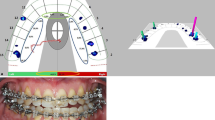Abstract
Aim:
It was the purpose of this study to analyze the relationship between selected types of malocclusion and specific types of static and dynamic orofacial dysfunction and to compare the results with subjects presenting regular occlusion. We aimed to identify which orthodontic and functional symptoms in early dentition would lead to malocclusion later on.
Subjects and Methods:
Occlusal relations and myofunctional status were evaluated in 3,041 children. We diagnosed dynamic and static myofunctional disorders as well as oral habits by means of functional examinations.
Results:
No orofacial dysfunctions were found in 11.2% of the children with primary dentition and in 10.2% of the children with early mixed dentition. We observed no correlation between the existence of distoclusion and functional disorders. Lateral crossbite in mixed dentition, as well as increased overjet and frontal open bite in primary and early mixed dentitions appeared significantly more frequently in children with orofacial dysfunctions. Individuals with frontal open bite, lateral crossbite, reduced and increased overjet presented static dysfunctions significantly more frequently than those in dentitions with normal occlusion. Dynamic dysfunctions were significantly more prevalent in subjects with frontal open bite and lateral crossbite than in those with normal occlusion.
Conclusions:
Our results enable us to prognosticate which children risk future orthodontic problems. Any child presenting one of the four occlusal disorders plus one static or two dynamic dysfunctions is a child more likely to develop orthodontic problems later on. Orthodontic prevention and early treatment must include functional rehabilitation so as to eliminate or at least diminish those factors causing undesirable developments.
Zusammenfassung
Ziel:
Ausgewählte Gebissanomalien sollen auf ihren Zusammenhang mit spezifischen statischen und dynamischen orofazialen Dysfunktionen untersucht und mit Probanden ohne Gebissanomalie verglichen werden. Prognostische Aussagen, bei welcher kieferorthopädischen und funktionellen Symptomatik mit einer risikobehafteten Gebissentwicklung zu rechnen ist, sollen abgeleitet werden.
Probanden und Methodik:
Bei 3041 Kindern wurden Okklusionsbefund und myofunktioneller Status erhoben. Dynamische und statische myofunktionelle Störungen sowie bestehende Habits wurden während der funktionellen Untersuchung diagnostiziert.
Ergebnisse:
Nur bei 11,2% und 10,2% der Kinder im Milch- und frühen Wechselgebiss mit Gebissanomalien wurden keine orofazialen Dysfunktionen nachgewiesen. Die Distalokklusion zeigte sich durch Funktionsstörungen nicht differenziert. Seitliche Kreuzbisse im Wechselgebiss sowie vergrößerte Frontzahnstufen und frontal offene Bisse im Milch- und frühen Wechselgebiss wurden signifikant häufiger bei Kindern mit orofazialen Dysfunktionen festgestellt. Statische Dysfunktionen traten beim frontal offenen Biss, seitlichen Kreuzbiss und bei reduzierten und vergrößerten sagittalen Frontzahnstufen signifikant häufiger auf als bei regelrechten Okklusionsverhältnissen. Dynamische Dysfunktionen lagen beim frontal offenen Biss und beim seitlichen Kreuzbiss signifikant häufiger vor als bei regelrechter Okklusion.
Schlussfolgerungen:
Die Ergebnisse lassen die Definition einer risikobehafteten Prognose zu. Das „kieferorthopädische Risikokind“ wird definiert, wenn bei einer der vier Okklusionsstörungen zusätzlich eine statische Funktionsstörung oder zwei dynamische Funktionsstörungen bestehen. Die Konzepte der kieferorthopädischen Prävention und Frühbehandlung müssen die funktionelle Rehabilitation zur Ausschaltung oder Reduzierung der Ursachen der Fehlentwicklung beinhalten.
Similar content being viewed by others
Author information
Authors and Affiliations
Corresponding author
Rights and permissions
About this article
Cite this article
Grabowski, R., Kundt, G. & Stahl, F. Interrelation between Occlusal Findings and Orofacial Myofunctional Status in Primary and Mixed Dentition. J Orofac Orthop 68, 462–476 (2007). https://doi.org/10.1007/s00056-007-0717-y
Received:
Accepted:
Issue Date:
DOI: https://doi.org/10.1007/s00056-007-0717-y
Key Words:
- Primary dentition
- Mixed dentition
- Visceral swallowing
- Sigmatism
- Oral habit
- Interceptive orthodontics
- Prevention
- Child




